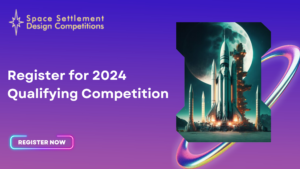 Before Space Settlement Design Competition® (SSDC) weekend Semi-Final events were started twenty years ago, there was only one way to earn an invitation to compete in the Finals: students formed Teams, recruited a responsible adult (usually but not always a teacher) to represent them, registered for the Qualifying Competition, prepared a 40-page report describing their space settlement design, sent it in, and waited for the Judging Team to complete their evaluation and announce winners.
Before Space Settlement Design Competition® (SSDC) weekend Semi-Final events were started twenty years ago, there was only one way to earn an invitation to compete in the Finals: students formed Teams, recruited a responsible adult (usually but not always a teacher) to represent them, registered for the Qualifying Competition, prepared a 40-page report describing their space settlement design, sent it in, and waited for the Judging Team to complete their evaluation and announce winners.
Although most Space Settlement Design Competition participants now experience weekend Semi-Finals events, the Qualifying Competition option still exists. Some Regions world-wide require Qualifying Competition entries in order to select Teams that will be invited to Regional Semi-Finals (outside of the U.S. and Canada, check with local Regional Coordinators for registration rules and deadlines). Students in the U.S. and Canada may do both, entering a Semi-Final as individuals, and forming Teams to enter the Qualifying Competition. Each year, winning Teams from eleven Semi-Finals world-wide earn invitations to Finals, and four Qualifying Competition Teams are invited as Finalists. Students who enter both Qualifying and a Semi-Final will see a different space settlement scenario for the two exercises—and winners see a third scenario at Finals.
The basic idea of both Semi-Final and Qualifying SSDCs is the same, and mirrors the process real engineers and managers in real companies go through in order to win contracts to do work for customers: SSDC organizers (customers) prepare a Request for Proposal (RFP) that defines requirements for a space settlement to be built in the future. The RFP describes what the customer wants the settlement to do, including population and economic activity. Each contractor (SSDC Team) develops a design in response to the RFP, and prepares a proposal that describes how their design accomplishes what the customer wants. The proposals for Semi-Finals are presented in the form of a 50-slide briefing to the Judging Panel; proposals for Qualifying are in the form of a 40-page written report plus Appendices, with three hard copies sent to a physical address.
An advantage to the Qualifying Competition format is that student Teams can set their own schedules and processes for how to complete the work. SSDC organizers have known Teams that met for a week during Spring Break to prepare proposals. Some Teams form a club that meets after school to do the work. Some Teams work on proposals for several weekends in a row. At least one high school has School Board approval to use the annual Qualifying exercise as a class project in AP Physics. Another high school has used the Qualifying exercise as a project in English class, as an example of how the English language is used in industry.
Although SSDC organizers encourage creative applications of Qualifying scenarios, we do emphasize one request: all SSDC exercises are intended to be worked on by Teams of students, not individuals. SSDCs are all about simulating real work in industry, and people in industry work together to create products. We suggest that Qualifying Teams have at least 12 participants (the number that will be invited to represent each Team at Finals). We have known of groups of dozens of students working on Qualifying proposals, which is great preparation for Finals, where Teams are matched into “Companies” of up to 64 students.
Note: it is necessary for each Team to register separately for the Qualifying Competition. Proposals received from Teams that have not registered will not be judged. If a school chooses to enter two Teams, each must register as a separate Team.
The deadline for 2024 Qualifying Proposals to be received by the Judging Team is Wednesday 27 March. Although some Teams registered and received RFPs in November and December last year, there is still plenty of time for Teams registering in February or early March to prepare a winning entry. Teams in the U.S. and Canada click on the “Register” button at spaceset.org to sign up and receive this year’s RFP, for a large commerce, banking, and transportation center in
Earth orbit. Teams in other Regions can inquire about options to enter, either through their local Regional Coordinator or “Contact Us” on the spaceset.org website.
A preliminary version of the 2025 Qualifying RFP will be prepared and sent to both the Australian and Asian Regional Coordinators in March. The Final RFP for U.S. and Canadian students is planned to be available in late November or early December 2024. Other Regional Coordinators may request Qualifying RFPs for use in their Regions.
